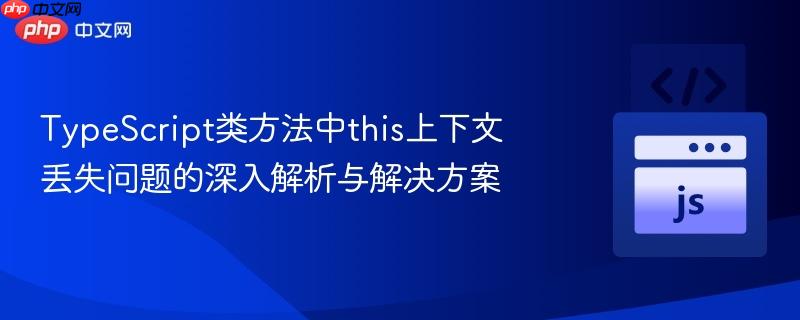
当typescript类方法中的`this`上下文意外变为`undefined`时,通常会导致`typeerror`,表现为无法读取类实例属性。本文将深入探讨`this`上下文在javascript/typescript中的工作原理,分析类方法中`this`丢失的常见原因,并提供使用箭头函数作为类属性方法的解决方案,以确保`this`始终正确指向类的实例,从而避免运行时错误,提升代码的健壮性。
在JavaScript(以及其超集TypeScript)中,this关键字是一个特殊的值,它指向函数执行时的上下文对象。this的值并非在函数定义时确定,而是在函数被调用时动态绑定的,其绑定规则主要取决于函数的调用方式。常见的绑定规则包括:
在类(Class)的上下文中,我们通常期望类方法中的this始终指向当前类的实例。然而,当类方法被“提取”出来,作为独立函数调用,或者作为回调函数传递给其他上下文时,this的隐式绑定规则可能会失效,导致this不再指向类的实例,而是根据其新的调用方式进行绑定。在严格模式下(ES模块默认启用严格模式),这通常会导致this变为undefined,进而引发TypeError: Cannot read properties of undefined (reading 'propertyName')的错误。
考虑以下Configs类:
import { log } from 'console';
// import { ITimeFrameTypes } from '../tbBot/bot.interface'; // 假设已定义
// 假设 ITimeFrameTypes 定义如下
type ITimeFrameTypes = '1m' | '5m' | '15m' | '1h' | '4h' | '1d' | '1M';
export class Configs {
private initMargin = 1;
private initLevrage = [
100, 90, 80, 70, 60, 50, 40, 30, 20, 15, 13, 11, 10, 8, 6, 5, 4, 3,
];
private timeFrames: ITimeFrameTypes[] = [
'1m',
'5m',
'15m',
'1h',
'4h',
'1d',
'1M',
];
checkFrameType(name: ITimeFrameTypes) {
let t: string = name;
if (name == '1M') {
t = '1mo';
}
return t;
}
getMarginInit() {
return this.initMargin;
}
setMarginInit(n: number) {
this.initMargin = n;
}
getLevrages() {
return this.initLevrage.map(x=>x);
}
getTimes() {
return this.timeFrames.map(x=>x);
}
// 存在潜在this上下文问题的传统方法
getTimeName(i: number) {
// 当此方法被错误调用时,this.initLevrage 可能为 undefined
log( typeof this.initLevrage); // 此时可能打印 'undefined'
let t = this.timeFrames[i];
return this.checkFrameType(t);
}
getTimeIndex(name: ITimeFrameTypes) {
let t = this.timeFrames.indexOf(name);
return t;
}
}在上述getTimeName方法中,如果调用方式不是myConfigInstance.getTimeName(index),而是:
const myConfig = new Configs(); const detachedGetTimeName = myConfig.getTimeName; // 此时调用 detachedGetTimeName(0) 将导致 this 丢失 // log(typeof this.initLevrage) 会打印 'undefined' // 进而尝试访问 this.timeFrames[i] 也会失败,因为 this 是 undefined detachedGetTimeName(0); // 抛出 TypeError: Cannot read properties of undefined (reading 'timeFrames')
这就是典型的this上下文丢失问题。
为了解决类方法中this上下文丢失的问题,最推荐且简洁的方法是使用箭头函数来定义类的方法。当箭头函数被用作类属性时,它们会捕获其定义时所处的词法环境中的this(即类的实例),并将其永久绑定。这意味着无论该方法如何被调用或传递,this都将始终指向类的正确实例。
将getTimeName方法修改为箭头函数形式:
import { log } from 'console';
// import { ITimeFrameTypes } from '../tbBot/bot.interface'; // 假设已定义
// 假设 ITimeFrameTypes 定义如下
type ITimeFrameTypes = '1m' | '5m' | '15m' | '1h' | '4h' | '1d' | '1M';
export class Configs {
private initMargin = 1;
private initLevrage = [
100, 90, 80, 70, 60, 50, 40, 30, 20, 15, 13, 11, 10, 8, 6, 5, 4, 3,
];
private timeFrames: ITimeFrameTypes[] = [
'1m',
'5m',
'15m',
'1h',
'4h',
'1d',
'1M',
];
checkFrameType(name: ITimeFrameTypes) {
let t: string = name;
if (name == '1M') {
t = '1mo';
}
return t;
}
getMarginInit() {
return this.initMargin;
}
setMarginInit(n: number) {
this.initMargin = n;
}
getLevrages() {
return this.initLevrage.map(x=>x);
}
getTimes() {
return this.timeFrames.map(x=>x);
}
// 使用箭头函数作为类属性方法,解决this上下文问题
getTimeName = (i: number) => {
log( typeof this.initLevrage); // 此时 this.initLevrage 将始终正确
let t = this.timeFrames[i];
return this.checkFrameType(t);
}
getTimeIndex(name: ITimeFrameTypes) {
let t = this.timeFrames.indexOf(name);
return t;
}
}现在,即使我们以分离的方式调用getTimeName:
const myConfig = new Configs(); const detachedGetTimeName = myConfig.getTimeName; detachedGetTimeName(0); // 正常执行,this.initLevrage 不再是 undefined
这是因为getTimeName = (i: number) => { ... } 这种语法实际上是将一个箭头函数赋值给类的实例属性getTimeName,而不是在原型链上定义一个方法。每个类实例都会拥有自己的getTimeName函数实例,并且这个函数在创建时就绑定了正确的this。
何时使用箭头函数方法?
性能考量:
替代方案:
TypeScript的noImplicitThis:
this上下文是JavaScript/TypeScript中一个核心且容易混淆的概念。理解其动态绑定机制对于编写健壮的代码至关重要。当在类方法中遇到TypeError: Cannot read properties of undefined并怀疑是this上下文问题时,将传统方法转换为箭头函数作为类属性方法,通常是解决此类问题的最直接和推荐的方式。这种模式确保了this的词法绑定,从而在任何调用场景下都能正确引用类的实例,极大地提升了代码的稳定性和可预测性。
以上就是TypeScript类方法中this上下文丢失问题的深入解析与解决方案的详细内容,更多请关注php中文网其它相关文章!

每个人都需要一台速度更快、更稳定的 PC。随着时间的推移,垃圾文件、旧注册表数据和不必要的后台进程会占用资源并降低性能。幸运的是,许多工具可以让 Windows 保持平稳运行。




Copyright 2014-2025 https://www.php.cn/ All Rights Reserved | php.cn | 湘ICP备2023035733号